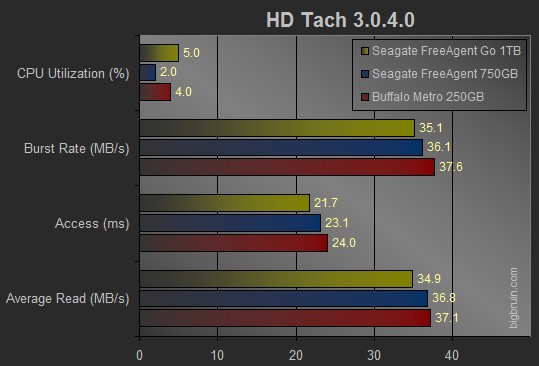Testing:
The Seagate FreeAgent Go 1TB portable hard drive was tested on a system with the following specifications:
» Intel Core 2 Duo E8600 processor
» 2GB DDR3 1333MHz memory
» Seagate 250GB 7200RPM SATA II hard drive
» Windows 7 Ultimate operating system



The Seagate FreeAgent Go will be tested against two other external hard drives:
»
Buffalo MiniStation Metro 250GB
»
Seagate FreeAgent Pro 750GB
The Buffalo MiniStation Metro is very similar to the FreeAgent Go in terms of features and physical size, while the 750GB FreeAgent Pro is larger with a 3.5" SATA II hard drive inside. During each of these benchmarks, there is one additional thing to keep in mind, the Buffalo MiniStation Metro has a capacity of 250GB while the FreeAgent Go has 1TB in the same form factor.
Three benchmarks and some real world file transfers will be used to test the three hard drives. Each of the hard drives will be reformatted before each test, and will not have any added features enabled.
» HD Tach 3.0.4.0
» HD Tune 2.55
» CrystalDiskMark 2.2
» Real World Transfer Speeds
HD Tach 3.0.4.0
HD Tach is an older benchmark which tests the random access read and write speeds of your hard drive. As with most benchmarks you want the highest burst rate and average read rate possible, while keeping the CPU utilization and access time to a minimum.

In this first benchmark, I was surprised. I expected the FreeAgent Go to be the leader of the pack, however what this benchmark showed is that the Buffalo MiniStation Metro outperformed the FreeAgent Go in the Burst, Average Read rates, and CPU utilization tests. However the FreeAgent Go was faster at accessing the drive.